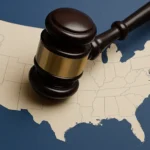
Today, the Supreme Court released its opinions in the Students for Fair Admission cases versus Harvard and UNC. In their decisions, the Court effectively overturned Grutter v. Bollinger and therefore prohibited the use of race as a factor in college admissions.
Justice Roberts, writing for the majority, held that race-based admissions policies established for the purpose of promoting diversity were in violation of the 14th Amendment Equal Protection Clause and could not be upheld under the “strict scrutiny” test.
According to Justice Roberts’ opinion, any violation of the equal protection guarantee must survive a “daunting two-step examination” called “strict scrutiny.” Under the “strict scrutiny” test, facially discriminatory government action, policy, or law can only be upheld if racial classification is used to “further compelling governmental interests,” Grutter v. Bollinger, , 539 U. S. 306, 326, and the use of race is “narrowly tailored” to the objective Fisher v. University of Tex. at Austin, 570 U. S. 297, 311–312.
The court first determined that discrimination in admissions policy was permissible and qualified as a “compelling government interest” in Bakke where Justice Powell noted that diversity is “a constitutionally permissible goal for an institution of higher education” 438 U. S., at 311–312. Powell advocated for a system with several limitations on the use of race in admissions: race could only be used as a “plus” but never as a minus, one could not entirely foreclose opportunities to individuals based solely on race, and one could not employ a two-track quota system. This framework was implemented in Grutter where, in addition to Powell’s limitations, the court determined that there must be some logical endpoint to affirmative action and that there must be no viable race-neutral alternative to achieve diversity in admissions. Justice O’Connor proposed that in 25 years “the use of racial preferences will no longer be necessary to further the interest approved today.” Id., at 343. Pp. 19– 21.
Since Grutter, 20 years have passed “with no end to race-based college admissions in sight.” The Court has now taken it upon themselves to reexamine the necessity of race-based admissions and has found its justifications and practices wanting. The Court first notes that the supposed benefits of diverse education are ambiguous, ill-defined, and “not sufficiently coherent for purposes of strict scrutiny.” Goals such as “training future leaders” or creating “engaged and productive citizens” through diverse education are not measurable, nor does the Court have any way of observing when they have been achieved. Such goals are “standardless” and cannot be compared to other measurable compelling interests which justify race-based policies (for instance, segregation in prisons to reduce racial gang violence). Johnson v. California, 543 U. S. 499, 512–513.
The Court also found that the means of achieving diversity were not “narrowly tailored.” Diversity was achieved in the Harvard and UNC admissions programs through overbroad racial classification of students which was both under- and over-inclusive. Since Grutter, universities have been provided broad discretion to pursue diversity as they see fit; the court will no longer be affording such deference.
Reaffirming the protections of the 14th Amendment, the Court also notes that in zero-sum games like admissions, the reasoning in Bakke is fundamentally flawed. There is no solely positive use of race as an admissions factor. Where race is used as a plus, it is necessarily a minus against others: “a benefit provided to some applicants but not to others necessarily advantages the former at the expense of the latter.”
The Court reasserts that there is no logical endpoint to the current race-based admissions policies implemented at Harvard and UNC. There is no way to know when students have received “the benefits of diversity” and thus there is no end to the project of race-based admissions.
Finally, the Court notes that previous discrimination cannot be remedied by more discrimination, and any effort to alleviate past discrimination is not a compelling government interest justifying existing race-based policies. The Court declares quite succinctly, “[e]liminating racial discrimination means eliminating all of it.”
Summarizing their decision, the Court notes that “because Harvard’s and UNC’s admissions programs lack sufficiently focused and measurable objectives warranting the use of race, unavoidably employ race in a negative manner, involve racial stereotyping, and lack meaningful end points, those admissions programs cannot be reconciled with the guarantees of the Equal Protection Clause.”
Students for Fair Admission Inc. v. President and Fellows of Harvard College will have a seismic effect on the structure of admissions policies across the nation. Any college engaging in racial balancing, using race as a “plus” factor, or justifying race-based policies only by appeal to the ambiguous “benefits of diversity” will be opening themselves to a barrage of civil rights litigation. In keeping with the 14th Amendment, colleges will, from here on out, only be allowed to consider race to the extent that it is used to illustrate an applicant’s life and character, but colleges may not consider race alone nor may they presume that students possess certain opinions or life experiences because of the color of their skin.
Justice Thomas also wrote a wide-ranging concurrence attacking the premise of affirmative action regimes as merely “the latest disguise for discrimination.” Indeed, as he warns, “though JUSTICE JACKSON [in her dissent] seems to think that her race based theory can somehow benefit everyone, it is an immutable fact that ‘every time the government uses racial criteria to ‘bring the races together,’ someone gets excluded, and the person excluded suffers an injury solely because of his or her race.’ Parents Involved, 551 U. S., at 759 (THOMAS, J., concurring) (internal citations omitted).” Ultimately, Justice Thomas celebrates the Court’s decision for recognizing how “the universities’ admissions policies… fly in the face of our colorblind Constitution and our Nation’s equality ideal.”
Like Justice Thomas, Landmark is also happy to see the Court rule in favor of the Students for Fair Admission. It’s a great day for color-blind policy and American meritocracy. While some on the fringes cling to toxic racial quotas, the Court recognizes that our Constitution requires a colorblind approach to university admissions.
Sonia Sotomayor once characterized this divide between herself and Justice Thomas: “[he] believes that everyone is capable of pulling themselves up by their bootstraps… [but] I believe not everyone can reach their bootstraps.” After today, more students – regardless of race – will feel empowered to earn the success uniquely found in the American meritocratic ideal. Furthermore, Landmark will remain vigilant in the face of universities which may seek to flout today’s decision. While today was a major victory, the fight to secure the equal standing of every American as envisioned by our Framers continues. One need look no further than the ongoing case in Coalition for TJ v. Fairfax County to see just how much work remains to be done.
SUPPORT LANDMARK LEGAL FOUNDATION
We are truly facing existential threats to our individual rights and liberties, the Constitution, and our national character. If unchallenged, this assault on our very way of life will ruin our great nation. With your financial and moral support, Landmark is not going to let that happen without a fight. Will you join us?





